Interview with Lidia Bastianich – Part 2 and a recipe for a Free-Form Peach Crostata
What does Lidia enjoy doing when she is not working or spending time with family? “I love to travel. Food is part of travel. What is wonderful when you travel is you look at the topography and climate. You can almost predict the food and how they relate. I love that part. I love the social aspect of food and eating. I like going back to the earth and sitting on the floor, eating with your hands. It talks to me and tells me with the senses. Fingers tell you so much. It is all beautiful. I love to see food served without a knife and fork.”
Her heritage and travel to Italy are not the only source of Lidia’s inspiration. What other countries and their cuisine have influenced her cooking? “Asian food. I discovered it when I first came to the states. It is an old culture and as different as it is from Italian culture, there are some parallels. I have traveled to Vietnam, Japan, China and Thailand. I would still like to go to Korea. To know food from another place is to know more than a dish. I need time. I need to know what their spices are. I am not even close to knowing all of them in Asian food.”
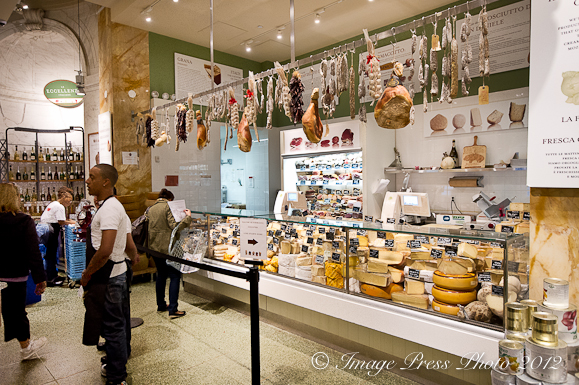
Imported cheeses and meats
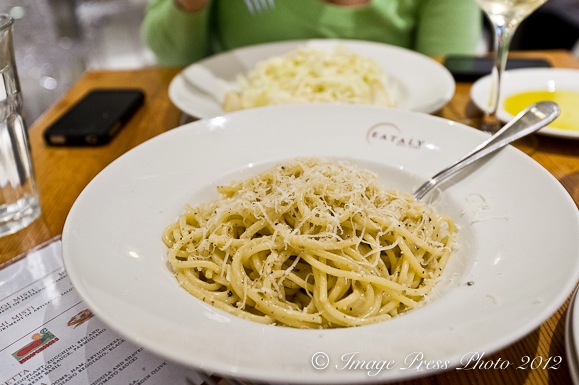
My favorite dish at Eataly was Spaghettone Cacio e Pepe
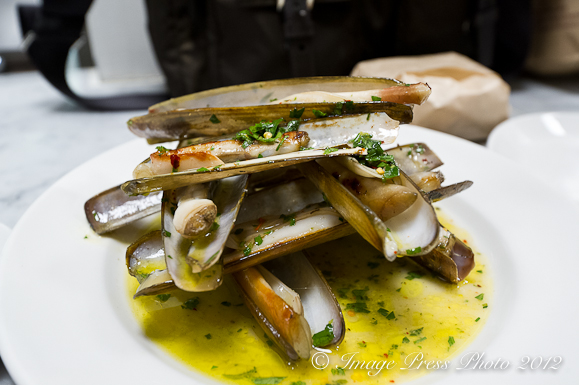
The razor clams were just like the ones we had in Barcelona
Lidia’s daughter Tanya and son Joe are a large part of her business empire. As she starts to think about the next chapter of her life, her family will continue to play an even more important role. “Retirement? I am thinking about it, ” Lidia told us. “I need a path, a precursor.” One thing has always led to another in her life. “It gives me great satisfaction to work with Tanya and Joe. Tanya can walk to my house and Joe lives 30 minutes away.” Tanya Bastinaich Manuali is a PhD, with degrees from Georgetown University and Syracuse University. She studied Italian Renaissance Art at Oxford University and has taught in Italy for both Boston University and Syracuse.
Her son, Joe Bastianich, left Wall Street to work with her on the restaurant expansions, Eataly, and the wineries based in Italy and is partner with Mario Batali in several restaurants, including Babbo. He is also involved in a number of other ventures.
Lidia’s mother, Erminia, age 93, who has made frequent appearances on Lidia’s shows and lives with Lidia, tends the garden at their home in New York City. Lidia’s five grandchildren are a big part of her life. Family is very important to her. Lidia shared, “Things move so fast in today’s world. It is unstable and we need stability. The whole world is pushing our kids ahead and forgetting about the back generations and the grandmas.”
“I wrote a children’s story for Christmas (Nonna Tell Me a Story: Lidia’s Christmas Kitchen). It is not just about Nonna (the Italian word for Grandmother) telling a story. There is a recipe. We finish the story and then do the recipe. I don’t just tell, we do,” Lidia told us. I remember spending a great deal of time with my grandmother when I was a young girl and it made a difference in my life. I do think we have lost that connection.
“We forget about the unconditional love, wisdom, richness and stability of our grandparents. I grew up with this and I know. I need to talk about this,” Lidia was passionate. “It’s a social plus for the kids. My young ones are growing. Where do they want to go? How can I help them get there? Grandmothers can be the inspiration for this.”
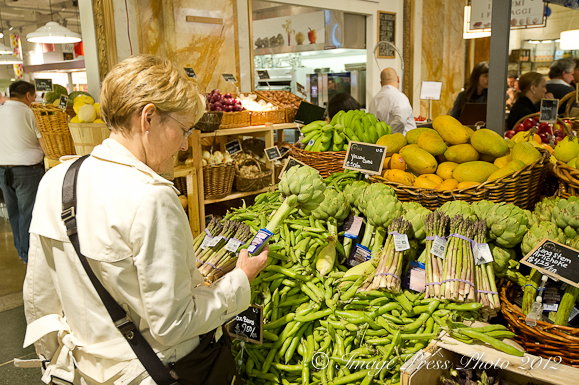
These were incredibly beautiful and fresh ingredients
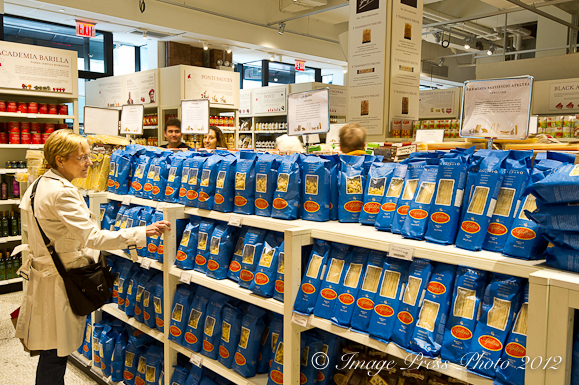
We brought home a supply of imported pasta
A final thought from Lidia on food and our lifestyle choices, “Life should be about passion. Not so programmed. Big companies say they are making our lives easier, but it’s more complicated. We need to return to basics.”
We want to thank Lidia for the time she spent with us and the passion that she brings to everything she does. Our conversation was like chatting with a close friend that shares the same values and feelings. I hope that we can bring more of that sentiment and knowledge to our readers.
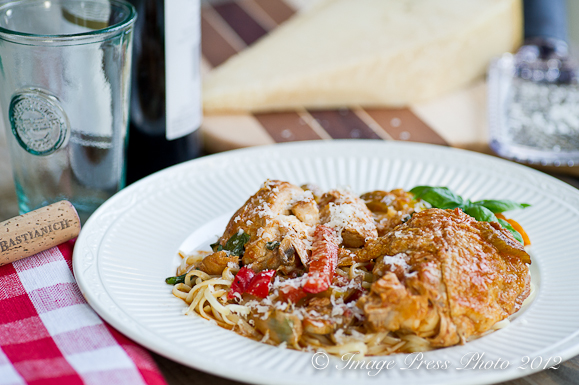
Chicken Cacciatore from Lidia’s Italy in America
I have made several of Lidia’s recipes in the past few weeks. One was for Rice and Zucchini Crostata (Torta di Riso e Zucchine) from Part 1 of my interview with Lidia. I also prepared a wonderful recipe for Chicken Cacciatore from Lidia’s Italy in America. The flavors in both dishes were excellent.
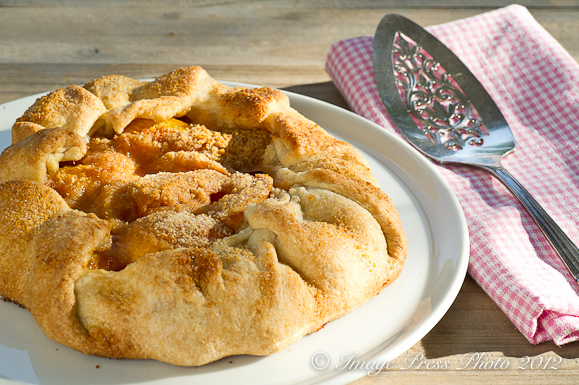
The natural sweetness of the ripe South Carolina peaches are featured in this dessert
For this article, I chose to make a Free-Form Peach Crostata since South Carolina peaches are at their peak with wonderful, juicy and sweet cling-free peaches available at almost every farmstand and Farmers’ Market in North Carolina, South Carolina, and Georgia. I used Lidia’s recipe for a crostata with Italian prune plums and substituted fresh peaches, as she suggests substituting any other ripe fruit.
I love the simplicity of this rustic tart. It is perfect for entertaining in the summer, especially when topped with a scoop of homemade vanilla ice cream. The crust was perfect and flaky and really highlights the flavor of the peaches. We enjoy tasting the natural sweetness of the fruit. If you want a sweeter crostata, you might add a little more sugar.
Bunkycooks will have more articles on Lidia’s Italy in the near future. In the meantime, Ciao!
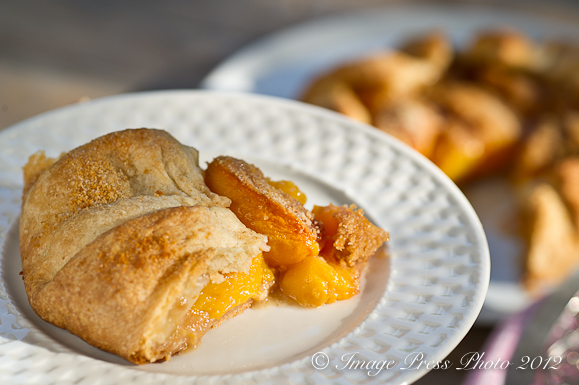
The crust is light and flaky and perfect with the peaches
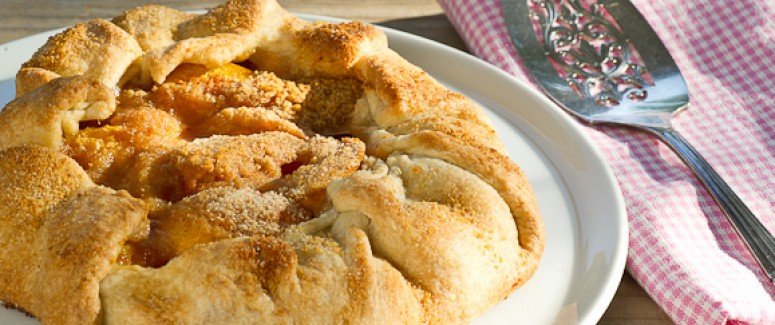
Free-Form Peach Crostata
Ingredients:
For Crostata Dough
1 cup all-purpose flour
2 tablespoons sugar
1/8 teaspoon salt
5 tablespoons butter, very cold
4 tablespoons water, very cold
For the Fruit Filling
1 1/2 pounds prune plums, or other ripe fruit
(I used South Carolina peaches)
Zest of 1 lemon, finely grated
2 tablespoons apricot jam
2 tablespoons butter, cut in pieces
For the Sweetened Bread Crumbs
1/2 cup fine dry bread crumbs
2 tablespoons zucchero di canna, or white sugar
1/4 teaspoon powdered cinnamon
For Serving (Optional)
Whipped cream or
vanilla ice cream
Directions:
For the Dough
1. Put the flour, sugar and salt in the bowl of a food processor fitted with the metal blade and process for a few seconds to mix the dry ingredients.
2. Cut the butter into 1/2-inch pieces, drop them onto the flour, and pulse the machine 10 or 12 times, in short bursts, 20 seconds in all. The mixture should be crumbly with only a few larger bits of butter visible.
3. Sprinkle 3 tablespoons of water on top of the dough-immediately pulse about 6 times, only a second or two each time. You want the crumbs to gather together in wet clusters, a bit like cottage cheese curds-don’t expect a mass of dough to form. If they haven’t gathered, sprinkle on more water, a teaspoon at a time, and pulse 2 or 3 times after each.
4. When the clusters form, scrape them all out of the bowl, press them together and knead just for a few seconds to form smooth, tight dough. Flatten it into a disk, wrap well in plastic wrap and refrigerate for 3 hours or up to a day before using. Freeze the dough for longer keeping.
(If the crumbs haven’t clustered after you’ve added 4 tablespoons of water, open the top and press them with your fingers-if they’re wet and stick together, just empty the bowl and press them into a disk of dough.)
Making the Filling and Rolling the Dough
1. Arrange a rack in the middle of the oven with a baking stone on it, if you have one. Preheat the oven to 375 degrees. If the crostata dough is very cold, let it soften at room temperature for a few minutes while you make the filling.
2. Rinse the plums and pat dry. Cut them in flat halves, following the natural line around the fruit through the stem end, and remove the pits. Toss the halves with the lemon zest, apricot jam and butter bits in a mixing bowl. (If you’re making the crostata with large plums or fruits like peaches or nectarines, cut them in quarters or wedges. *I peeled my peaches before slicing them.)
3. Toss the bread crumbs, sugar and cinnamon together.
4. On a lightly floured board, start stretching the dough into a circle, rolling from the center in all directions. Turn the dough over as it stretches and flour the work surface as needed. Cut a piece of parchment that will cover your baking sheet. Roll the circle of dough to a diameter of 15-inches and lay it, centered, on the parchment. Now trim the outside edges of the dough, with a sharp knife or scissors, cutting away ragged or thin spots and making as perfect a round as you can, since this edge will be visible on the top of your crostata. Keep the circle at least 13-inches diameter. Lift the parchment with the dough on it to the baking sheet.
Filling and Baking the Crostata
1. Sprinkle about 1/3 cup of the bread crumb mix in a 7 to 9-inch diameter circle in the center of the dough, as a base for the fruit. The bread crumbs will soak up the juices, so if you have very ripe and juicy fruit (like peaches), use more crumbs to form a thicker layer; if using a drier fruit, like apricots, use less crumbs.
Arrange the coated plum halves, cut side up, on top of the crumb base. I place them in concentric rings, starting from the outside, and lean each inner ring on the plums just outside. In this manner, with a larger 8 or 9-inch base of crumbs, you should be able to fit all the plums in one layer, for a crostata with an even height. If the crumb base is smaller, you’ll need to pile up the fruit. This will give the crostata more of a dome shape.
2. When you’ve assembled your fruit in the middle of the dough, you’ll fold the uncovered band of pastry on top of the fruit. The width of the band will vary with your arrangement of the plums, but you should have at least 2-1/2 inches of dough to form the pleated top crust. Finally, sprinkle 1 or more tablespoons of sugared bread crumbs over the visible fruit in the center. As before, use more crumbs on juicy fruit. If you have any left over, sprinkle them over the pleated dough.
3. Put the baking sheet with the crostata into the oven, on the stone if using one, and bake for 25 minutes; rotate the pan back to front for even cooking. Continue baking and check the browning of the crust after 40 minutes: it should be light gold. If it is getting quite dark, you may need to lay a piece of foil on top. Bake for another 15 minutes or more until the fruit is bubbling and has caramelized on the edges. If you’ve filled the crostata with a mound of fruit, you’ll probably want to bake it more than an hour-and cover the top-to make sure all the fruit is cooked.
4. Let the crostata cool on the baking sheet for about 15 minutes or more before lifting it, with the parchment, to a wire rack to continue cooling. When it has set, slide it off the parchment, supported by long spatulas, onto a platter. Serve warm or at room temperature, cut in wedges, with whip cream or vanilla if you wish.
Lidia Bastianich
Recipe courtesy of LidiasItaly.com
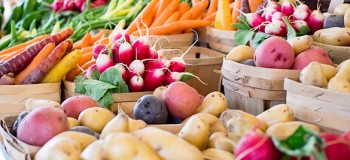















I love Lidia’s recipes and her approach to food. Linguini dressed simply in olive oil, garlic and cheese is one of life’s great pleasures. I have a 30-year-old Lidia recipe for gnocchi with veal and it is divine.
Thanks for such a delightful interview with Lidia (both parts I and II). She is truly a woman—and chef—worth watching. It’s heartening to know that knowledgeable, passionate culinary “stars” still exist in today’s virtual world full of egomaniacs.
Lidia is a class act and I love her authentic Italian style. I am so bummed that I didn’t have a chance to go to Eataly when I was in NYC recently – next time for sure. And those Razor Clams look AH-mazing. Wonderful interview and great photos!
Lidia gives a great interview. I was pulled in completely and surprised to find out that Asian food has been an inspiration to her. I also agree with her assertion that nowadays the ‘don’t eat this’ and ‘don’t eat that’ is kind of ridiculous. How can you enjoy life constantly restricting yourself? Eat what you want – portion control! By the way..Joe Bastianich’s ‘other’ ventures just so happen to include the ‘tough’ judge of Masterchef. LOL Did that come up at all?
Finally..I love eating with my fingers if it’s not saucy or wet..when I’m alone, of course! Amazing interview, Gwen, and that’s a fabulous photo of Lidia! I’m making the peach crostata as soon as I find peaches that make me weak in knees when I take a whiff 🙂
Hi Lisa,
Thank you. We totally agree with all the negativity in the way people are told to eat. Rather, we should teach people to eat in moderation and eat the right foods. That is a far more sustainable way of managing your eating habits and diet throughout your lifetime.
We did not talk specifically about Masterchef when Lidia mentioned Joe, but he is very involved with many of Lidia’s businesses in addition to his own ventures.
Gwen
Love this part even more and just LOVE Eataly. We’ve luckily been there twice and I really want to visit the Eataly in Torino next time we are there. Fabulous products and the pasta section is simple and delicious like the way we love it. Good ? from Lisa. Did the Masterchef topic come up about Joe?:) Wonderful job and how lucky you were to have spent time with her.
Hi Lora,
Yes, we need to go to Eataly! I still cannot stop thinking about how incredible it was.
Lidia did talk about Joe and how much he is involved in the businesses and how close the family is, but we never discussed Masterchef. He has so many ventures he is involved in, so that was not singled out.
Gwen
Fantastic interview and article, Gwen. Just fabulous! I have to say that in moving to and living in both France and Italy I did indeed learn to enjoy food and eating food instead of my guilt and all the don’t’s guiding how and what I ate (or refused myself). I began taking great pleasuring in discovering fresh, seasonal ingredients and cooking and eating. And never felt better. She is absolutely right. The problem in the US (and you know how I feel) is the quantity of boxed, packaged and processed foods that exist that do not exist in France and Italy and people have gotten used to eating that. How hard it would be to get them to give it all up and try and rediscover the joys and pleasures of real, fresh food? Eataly is amazing and I am so sad I didn’t take the time to go in and discover it when I was in NYC! Maybe I was afraid of being too tempted to buy and try everything?! But this peach crostata I willd definitely try! It’s fabulous!
I have become very confident with making pie dough. I can’t believe I just said that. However, I have a lot of trouble with stone fruit pie or crostatas. I can never get the sugar right, and it is either too loose or too dry. It seems fine before it goes into the oven, but not so much after it has baked. I am very frustrated. Maybe the use of the sweetened bread crumb will be the answer. I am a little concerned about it being mushy from the crumbs. Your thoughts please.